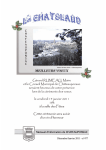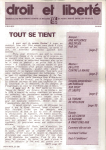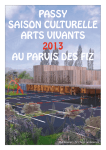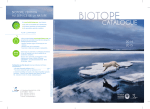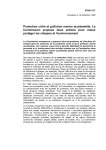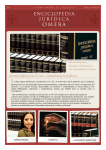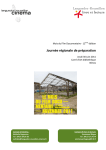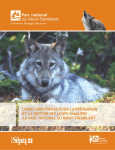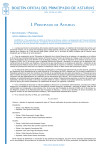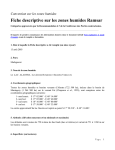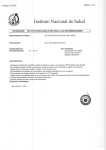Download Bibliografía - CBD
Transcript
Referencias bibliográficas Referencias BIBLIOGRÁFICAS REFERENCIAS BIBLIOGRÁFICAS Alda, F.; Alcaraz, L.; Hernández, M.; Doadrio, I.; García-Garitagoitia, J.L.; Gaitero, T. 2006. Estudio genético e inmunológico del conejo silvestre: implicaciones epidemiológicas y poblacionales de las traslocaciones y reintroduicciones. Informe inédito. Departamento de Biodiversidad y Biología Evolutiva. Museo Nacional de Ciencias Naturales, CSIC, Madrid. Aldama, J.J. 1993. Ecología energética y reproductiva del lince ibérico en Doñana. Tesis Doctoral inédita. Universidad Complutense. Madrid. Aldama, J.J.; Beltrán, J.F.; Delibes, M. 1991. Energy expenditure and prey requirements of free-ranging Iberian lynx in southwestern Spain. Journal of Wildlife Management, 55(4): 635-641. Angulo, E. 2001. When DNA research menaces diversity. Nature, 410: 739. Angulo, E.;, Cooke, B. 2002. First synthesize new viruses then regulate their release? The case of the wild rabbit. Molecular Ecology, 11: 2703-2709. Angulo, E.; Villafuerte, R. 2004. Modelling hunting strategies for the conservation of wild rabbit populations. Biological Conservation, 115: 291-301. Argüello, JL.; Llano, A.; Pérez-Ordoyo García, LL. 1998. Enfermedad vírica hemorrágica del conejo en España. Medicina Veterinaria, 5 (12): 645-650. Arsuaga, J.L.; Martínez, I. 1998. La especie elegida. Temas de Hoy. Madrid. Asgari, S, Hardy, JR, Cooke, BD. 1999. Sequence analysis of rabbit haemorrhagic disease virus (RHDV) in Australia: alterations after its release. Archives of Virology, 144: 135-145. Aymerich, M. 1982. Etude comparative des régimes alimentaires du lynx pardelle (Lynx pardina) et du chat sauvage (Felis sylvestris). Mammalia, 46: 515-521. Baker, P.J.; Harris, S. 2006. Does culling reduce fox (Vulpes vulpes) density in commercial forests in Wales, UK? European Journal of Wildlife Research, 52(2): 99-108. Ballesteros, F. 1998. Las especies de caza en España. Estudio y Gestión del Medio. Oviedo. 245 MANUAL PARA LA GESTIÓN DEL HÁBITAT DEL LINCE IBÉRICO Bandelt, H.J.; Forster, P.; Röhl, A. 1999. Median-joining networks for inferring intraspecific phylogenies. Molecular Biology and Evolution 16: 37-48. Banks, P. B. 2000. Can foxes regulate rabbit populations? Journal of Wildlife Management, 64: 639-648. Bárcena, J.; Morales, M.; Vázquez. B.; Boga, J.A.; Parra, F.; Lucientes, J.; Pagèes-Manté, A.; Sánchez-Vizcaíno, J.M.; Blasco, R.; Torres, J.M. 2000. Horizontal transmissible protection against Myxomatosis and Rabbit Hemorrhagic Disease by using a recombinant myxoma virus. Journal of Virology. 74: 1114-1123. Barlow, N.D.; Barron. M.C.; Parkes, J.P. 2002. Rabbit haemorrhagic disease in New Zealand: field test of a disease-host model. Wildlife Research 29: 649-653. Beltrán, J.F.; Delibes, M. 1993. Physical characteristics of Iberian lynxes from Doñana. Journal of Mammalogy, 74(4): 852-862. Beltrán, J.F.; Rice, J.E.; Honeycutt, R.L. 1996. Taxonomy of the Iberian lynx. Nature, 379: 407408. Bennett, E.L.; Robinson, J.G. 2000. Hunting for the Snark. En: Hunting for sustainability in tropical forests (Ed. J.G. Robinson y E.L. Bennett), pp. 13-30. New York, USA: Columbia University press. Best, S.M.; Kerr, P.J. 2000. Coevolution of host and virus: the pathogenesis of virulent and attenuated strains of myxoma virus in resistant and susceptible European rabbits. Virology 267: 36-48. Biju-Duval, C.; Ennafaa, H.; Dennebouy, N.; Monnerot, M.; Mignotte, F.; Soriguer, R.; Gaaïed, E.; Hili, A.E.; Mounolou. A. 1991. Mitochondrial DNA evolution in lagomorphs: origino f systematic heteroplasmy and organization of diversity in European rabbits. Journal of Molecular Evolution, 33: 92-102 Blanco, J.C. 1998. Mamíferos de España. II vol. Planeta. Barcelona. Blanco, J.C.; Barrios, L. 1997. Inventario, situación y plan de recuperación del lince ibérico en Extremadura. Informe inédito. Junta de Extremadura. Mérida. Blanco J.C.; Villafuerte, R. 1993. Factores ecológicos que influyen sobre las poblaciones de conejos. Incidencia de la enfermedad hemorrágica. Informe inédito. TRAGSA. Madrid. Blas, C. 1989. Alimentación del conejo. Mundi-Prensa. Madrid. Blas, C.; González, G.; Argamentería, A. 1986. Nutrición y alimentación del ganado. MundiPrensa. Madrid. Boyd, I.L.; Myhill, D.G., 1987. Seasonal changes in condition, reproduction and fecundity in the wild European rabbit (Oryctolagus cuniculus). Journal of Zoology, 212: 223-233. 246 REFERENCIAS BIBLIOGRÁFICAS Branco, M.; Machado, J.C.; Ferrand, N. 1999. Extensive genetic polymorphism of peptidases A, B, C and D, in wild rabbit (Oryctolagus cuniculus) populations from the Iberian Peninsula. Biochemical Genetics, 37: 237-249. Branco, M.; Ferrand, N.; Monnerot, M. 2000. Phylogeography of the European rabbit (Oryctolagus cuniculus) on the Iberian Peninsula inferred from RFLP analysis of the cytochrome b gene. Heredity, 85: 307-317. Branco, M.; Monnerot, M.; Ferrand, N.; Templeton, A.R. 2002. Postglacial dispersal of the European rabbit (Oryctolagus cuniculus) on the Iberian Peninsula reconstructed from nested clade and mismatch analyses of the mitochondrial DNA genetic variation. Evolution, 56: 792-803 Bravo, A. 2003. Resolveos de conversión en montes bajos de la región central de la Península Ibérica. Tesis Doctoral inédita. E.U.I.T. Forestal. Madrid Brown, A.L.; Litvaitis, J.A. 1995. Habitat features associated with predation of New England cottontails: What scale is appropriate? Canadian Journal of Zoology, 73: 1005-1011. Cabrera, A. 1914. Fauna Ibérica. Mamíferos. Museo Nacional de Ciencias Naturales. Madrid. Cacho, C., 2002. Utilización de siembras experimentales de pasto permanente y cultivo forrajero por una población de conejo (Oryctolagus cuniculus) en la ZEPA de los Montes de Toledo. Proyecto Fin de Carrera. ETS de Ingenieros de Montes. Universidad Politécnica de Madrid. Callou, C. 1995. Modifications de l’aire de répartition du lapin (Oryctolagus cuniculus) en France et en Espagne, du Pléistocene à l’époque actuelle. Etat de la question. Anthropozoologica, 21: 95-114. Calvete, C. 2002. Biología y gestión del conejo silvestre. Cuadernos de caza y pesca de Aragón. Gobierno de Aragón. Zaragoza. Calvete, C. 2006a. Los problemas de gestión del conejo silvestre. Quercus, 244: 17-20. Calvete, C. 2006b. Modeling the Effect of Population Dynamics on the Impact of Rabbit Hemorrhagic Disease. Conservation Biology, 20(4): 1232-1241. Calvete, C.; Angulo, E.; Estrada, R.; Moreno, S.; Villafuerte, R. 2005. Quarantine length and survival of translocated European wild rabbits. Journal of Wildlife Management, 69(3): 10631072. Calvete, C.; Estrada, R. 2004. Short-term survival and dispersal of translocated European wild rabbits. Improving the release protocol. Biological Conservation, 120: 507-516. Calvete, C.; Estrada, R.; Osacar, J.J.; Lucientes, J.; Villafuerte, R. 2004a. Short-term negative effects of vaccination campaigns against myxomatosis and viral hemorrhagic disease (VHD) on the survival of european wild rabbits. Journal of Wildlife Management, 68: 198-205. 247 MANUAL PARA LA GESTIÓN DEL HÁBITAT DEL LINCE IBÉRICO Calvete, C.; Estrada, R.; Osacar, J.J.; Lucientes, J.; Villafuerte, R. 2004b. Effects of vaccination against viral haemorrhagic disease myxomatosis on long-term mortality rates of European wild rabbits. The Veterinary Record, 155: 388-392. Calvete, C.; Estrada, R.; Villafuerte, R.; Osacar, J.J.; Lucientes, J. 2002. Epidemiology of viral haemorragic disease and myxomatosis in a free-living population of wild rabbits. Veterinary Record, 150: 776-782. Calvete, C.; Pelayo, E.; Sampietro, J. 2006. Habitat factors related to wild rabbit population trends after the initial impact of rabbit haemorrhagic disease. Wildlife Research, 33(6): 467474. Calvete, C.; Villafuerte, R.; Lucientes, J.; Osacar, J.J. 1997. Effectiveness of traditional wild rabbit restocking in Spain. Zool. Lond., 241: 271-277. Calzada, J. 2000. Impacto de depredación y selección de presa del lince ibérico y el zorro sobre el conejo. Tesis Doctoral inédita. Universidad de León. León. Calzada, J.; Palomares, F. 1996. Frecuencia de aparición de diferentes restos de conejo en excrementos de lince y zorro. Doñana Acata Vertebrata, 23: 243-252. Chasey, D.; Trout, R.C.; Edwards, S. 1997. Susceptibility of wild rabbits (Oryctolagus cuniculus) in the United Kingdom to rabbit haemorrhagic disease (RHD). Veterinary Research 28: 271-276. Clevenger, A. 1987. Observación de un lince ibérico (Lynx pardina) en la provincia de Lugo, Norte de España. Doñana Acta Vertebrata, 14: 140-142. Collery, P.M.; Mooney, J.; O’Connor, M.; Nowotny, N. 1995. Rabbit haemorrhagic disease in Ireland. Veterinary Records, 28: 271-276. CNPN. 2004. Comisión Nacional de Protección de la Naturaleza. Estrategia nacional contra el uso ilegal de cebos envenenados en el Medio Natural. Dirección General para la Biodiversidad. Ministerio de Medio Ambiente. Madrid. Consejería de Medio Ambiente. Junta de Andalucía. 2005. Decreto 182/2005, de 26 de Julio, por el que se aprueba el Reglamento de Ordenación de la Caza (BOJA no 154). Cooke, B.D. 1981. Rabbit control and the conservation of native Mallee vegetation on roadsides in south Australia. Australian Wildlife Research, 8: 627-636. Cooke, B.D. 1990. Rabbit burrows as environments for European rabbit fleas, Spilosyllus cuniculi (Dale), in arid South Australia. Australian Journal of Zoology, 38: 317-325. Cooke, B.D. 1999. Notes on the life-history of the rabbit flea Caenopsylla laptevi ibera Beaucournu y Márquez, 1987 (Siphonaptera: ceratophyllidae) in eastern Spain. Parasite, 6: 347-354. 248 REFERENCIAS BIBLIOGRÁFICAS Cooke, B.D.; Fenner, F. 2002. Rabbit haemorrhagic disease and the biological control of wild rabbits, Oryctolagus cuniculus, in Australia and New Zealand. Wildlife Research, 29: 689706. Corominas, J. 1987. Breve diccionario etimológico de la lengua castellana. Gredos. Madrid. Costa J.C. 2002. Manual para la diversificación del paisaje agrario. Consejería de Medio Ambiente. Junta de Andalucía. Sevilla. Costa, J.C. (Dir.) 2004. Modelos de restauración forestal. IV tomos. Junta de Andalucía. Sevilla. Cotilla, I.; Villafuerte, R. 2003. Empleo de modelos para la mejora de los traslados de conejos. En C. Gortázar, P. Ferreras, G. Jordán, A. Boixo, y. A. Castro (Eds.) VI Jornadas españolas de conservación y estudio de los mamíferos. SECEM. Ciudad Real. Covisa, J. 1998. Ordenación cinegética: Proyectos de Ordenación y Planes Técnicos. Auryn, S.A. Madrid. Daniel, P.W.; Helms, U.E.; Baker, F.S. 1979. Principles of Silviculture. MacGraw-Hill. New York. Delibes, M. 1979. Le lynx dans la péninsule ibérique- répartition et régression, predation. Bulletin Mensuel de l’Office de la Chasse, numéro spécial scientifique et technique, pp: 4157. Office National de la Chasse. París. Delibes, M.; Hiraldo, F. 1981. The rabbit as a prey in the Iberian Mediterranean ecosystem, In: Myers, K. and MacInnes, C.D. (eds) Proceedings of the World Lagomorph Conference. pp. 614-622. University of Guelph. Guelph, Canada Delibes, M.; Rodríguez, A. 1990. El lince ibérico (Lynx pardina) en España. Distribución y problemas de conservación. ICONA. Ministerio de Agricultura, Pesca y Alimentación. Madrid Delibes, M. 1980a. El lince ibérico: ecología y comportamiento alimenticio en el Coto de Doñana, Huelva. Doñana Acta Vertebrata, 7: 1-128. Delibes, M. 1980b. Feeding ecology of the Spanish lynx in the Coto Doñana. Acta Theriologica, 25(4): 309-324. Delibes, M.; Delibes de Castro, M. 2005. La Tierra herida. Destino. Barcelona. Delibes, M.; Rodríguez, A.; Ferreras, P. 2000. Action plan for the conservation of the Iberian lynx in Europe (Lynx pardinus). Nature and Environment Series, 111. Consejo de Europa. Estrasburgo. Díaz, E. 2004. Modelización de la calidad del hábitat para la perdiz roja silvestre (Alectoris rufa): el caso de Las Ensanchas (Ciudad Real). Proyecto fin de carrera. Universidad de Lleida. Dirección General de Biodiversidad. 2006. Estrategia para la conservación del Lince Ibérico (Lynx pardinus) en España. Ministerio de Medio Ambiente. Madrid. Duchaufour, Ph. 1987. Manual de edafología. Masson. París. 249 MANUAL PARA LA GESTIÓN DEL HÁBITAT DEL LINCE IBÉRICO Ennafaa, H.; Monnerot, M.; Gaaied, A.; Mounolou, J.C. 1987. Rabbit mitochondrial DNA: preliminary comparison between some domestic and wild animals. Génet. Sél. Évol. 19: 279288. Fedriani, J.M.; Palomares, F.; Delibes, M.; 1999. Niche relations among three sympatric Mediterranean carnivores. Oecologia, 121: 138-148. Fenner, F.; Fantini, B. 1999. Biological control of vertebrates pests: the history of myxomatosis – an experiment in evolution. Oxon, UK: CABI Publishing Ferreras, P.; Terriza, J.; López-Precioso, B.; Rodríguez, O.; Reglero, M.; Castro, F. 2003. Homologación de métodos de control de predadores en Castilla-La Mancha: bases científicas. Informe final. IREC. Consejería de Agricultura y Medio Ambiente. Junta de CastillaLa Mancha. Ciudad Real. Fernández de Cañete, J. 1979. Guía de la caza menor. Ministerio de Comercio y Turismo. Madrid. Fernández, N. 2003. Modelos de hábitat para el lince ibérico orientados a la conservación. Tesis Doctoral inédita. Universidad Complutense de Madrid. Fernández, N.; Palomares, F. 2000. The selection of breeding dens by the endangered Iberian Lynx (Lynx pardinus): implications for its conservation. Biological Conservation, 94: 5161. Fernández, N.; Palomares, F.; Delibes, M. 2002. The use of breeding dens and kitten development in the Iberian lynx (Lynx pardinus). Journal of Zoology, 258: 1-5. Fernández-González, F. 2004. Bioclimatología. En: Izco, J. (Coord.) Botánica. MacGraw Hill Interamericana. Madrid. pp: 715-794. Fernández-Llario, P.; Mateos-Quesada, P. 2003. Population structure of the wild boar (Sus scrofa) in two Mediterranean habitats in the western Iberian Peninsula. Folia Zool., 52(2): 143-148. Ferrand, N. 1995. Variçao genética de proteinas em poulaçoes de coelho (Oryctolagus cuniculus). Tesis Doctoral Inédita, Universidade do Porto. Ferrer, M. 1993. El águila imperial. Quercus, Madrid, España. Ferrera, E.M.; Olea, L.; Viguera, F.J.; Poblaciones, M.J. 2005. Mejora de pastos naturales con aplicación de diferentes fuentes fosfóricas y yeso en suelos de rañas y rañizos en el este de Extremadura. En: Roza, B.; Martínez, A.; Carballal, A (Eds.) Producciones agroganaderas. Gestión eficiente y conservación del medio natural. Gijón. pp: 565-572. Ferrera, E.M.; Olea, L.; Viguera, F.J.; Poblaciones, M.J. 2006. Influence of the phosphoric fertilization in grasses of “dehesas” of degraded areas. Grassland Science in Europe, 11: 95-97. 250 REFERENCIAS BIBLIOGRÁFICAS Ferreras, P. 1994. Patrones de dispersión del lince ibérico (Lynx pardina) en Doñana e implicaciones para su conservación. Tesis Doctoral inédita. Universidad Autónoma de Madrid. Madrid. Ferreras, P. 2001. Landscape structure and asymmmetrical inter-patch connectivity in a metapopulation of the endangered Iberian lynx. Biological Conservation, 100: 125-136. Ferreras, P.; Aldama, J.J.; Beltrán, J.F.; Delibes, M. 1992. Rates and causes of mortality in a fragmented population of Iberian lynx (Felis pardina Temminck, 1824). Biological Conservation, 61: 197-202. Ferreras, P.; Beltrán, J.F.; Aldama, J.J.; Delibes, M. 1997. Spatial organization and land tenure system of the endangered Iberian lynx (Lynx pardinus). Journal of Zoology, 243: 163-189. Ferreras, P.; Delibes, M.; Palomares, F.; Fedriani, J.M.; Calzada, J.; Revilla, E. 2004. Proximate and ultimate causes of dispersal of the Iberian lynx (Lynx pardinus). Behavioural Ecology, 15(1): 31-40. Ferreras, P.; Gaona, P.; Palomares, F.; Delibes, M. 2001. Restore habitat or reduce mortality? Implications from a population viability analysis of the Iberian lynx. Animal Conservaction, 4: 265-274. FIC. 2006. Fur Institute of Canada. Traps. meeting requirements of Agreement on International Human Trapping Standars and certification status. Certified traps. Updated December 8. Canadá. Forrester, N.L.; Trout, R.C.; Turner, S.L.; Nelly, D.; Boag, B.; Moss, S.; Gould, E.A. 2006. Unravelling the paradox of rabbit haemorrhagic disease virus emergence, using phylogenetic analysis; possible implications for rabbit conservation strategies. Conservation Biology, 131: 296306. Forrester, N.L.; Trout, R.C.; Gould, E.A. 2007. Benign circulation of rabbit haemorrhagic disease virus on Lambay Island, Eire. Virology, 358(1): 18-22. Fundación CBD-Habitat, 2002. Proyecto LIFE99/NAT/E/006336 Conservación del Águila imperial, Buitre negro, Cigüeña negra y Lince ibérico. Informe final de resultados inédito. Madrid Fundación CBD-Habitat, 2005. Proyecto LIFE03/NAT/E/00050 Conservación del Águila imperial, Buitre negro y Cigüeña negra. Informe parcial inédito. Madrid Fundación CBD-Hábitat. 2003. Proyecto LIFE99/NAT/E/006336 “Conservación del Águila imperial, Buitre negro, Cigüeña negra y Lince ibérico”. Informe Final inédito. Madrid. Fundación CBD-Hábitat. 2006a. Programa de alimentación suplementaria del lince ibérico (Lynx pardinus Temminck 1827). Análisis y evaluación. Conservación del lince ibérico en Sierra Morena oriental. Proyecto LIFE/02/E/NAT/8609 “Recuperación de las poblaciones de lince ibérico en Andalucía”. Documento inédito. Madrid. 251 MANUAL PARA LA GESTIÓN DEL HÁBITAT DEL LINCE IBÉRICO Fundación CBD-Hábitat. 2006b. Análisis de la presencia de otros carnívoros en relación al lince ibérico (Lynx pardinus Temminck, 1827) en Sierra Morena oriental. Conservación del lince ibérico en Sierra Morena oriental. Proyecto LIFE/02/E/NAT/8609 “Recuperación de las poblaciones de lince ibérico en Andalucía”. Documento inédito. Madrid. Fundación CBD-Hábitat. 2006c. Resultados y conclusiones de las Encuestas y Jornadas de debate. Proyecto LIFE02/NAT/E/8617. Fundación CBD-Hábitat. Madrid. Fundación LAIA Natura, 2003. Construcción de un bebedero. Trofeo, 399: pp 54-56. Fundación LAIA Natura, 2003. Colocación y desinfección de un bebedero. Trofeo, 398: pp 4849. Gaona, P.; Ferreras, P.; Delibes, M. 1998. Dynamics and viability of a metapopulation of the endangered Iberian lynx (Lynx pardinus). Ecological Monographs, 68(3): 349-370. García, J. F. 2003. Revisión de las actuaciones para el fomento de las poblaciones de conejo de monte. Informe inédito. Dirección General para la Biodiversidad. Ministerio de Medio Ambiente. Madrid. García, J. F. 2005. Manual técnico para el fomento de las poblaciones de conejo. Informe inédito. Dirección General para la Biodiversidad. Ministerio de Medio Ambiente. Madrid. García Perea, R. 1997. Phylogeny and conservation of Iberian lynxes. Cats News, 27: 23-24. Gea-Izquierdo, G.; Muñoz, J.; San Miguel, A. 2005. Rabbit warren distribution in relation to pasture communities in Mediterranean habitats: consequences for management of rabbit populations. Wildlife Research, 32: 1-9. Geraldes, A.; Ferrand, N.; Nachman, M.W. 2006. Contrasting patterns of introgression at X-linked loci across the hybrid zone between subspecies of the European rabbit (Oryctolagus cuniculus). Genetics, 173: 919-933. Geraldes, A.; Rogel-Gaillard, C.; Ferrand, N. 2005. High levels of nucleotide diversity in the European rabbit (Oryctolagus cuniculus) SRY gene. Animal Genetics, 36: 349-351. Gil, J.M.; Simón, M.A.; Cadenas, R.; Leiva, A.; Bueno, J.; Moral, M.; Rodríguez, J. 2006. Valle del Yeguas: éxito en la conservación del lince en su hábitat. Quercus, 244: 10-16. Gómez-Sal, A.; Rey-Benayas, J.M.; López-Pintor, A.; Rebollo, S. 1999. Role of disturbance in maintaining a savanna-like pattern in Mediterranean Retama sphaerocarpa shrubland. Journal of Vegetation Science, 10: 365-370. González Molina, J.M. 2005. Introducción a la selvicultura general. Universidad de León. Ponferrada. González Vázquez, E. 1948. Selvicultura. Libro segundo: estudio cultural de las masas forestales y los métodos de regeneración. Residencia de Profesores. Ciudad Universitaria. Madrid. González, J.A. 1998. Non-natural mortality of the Iberian lynx in the fragmented population of Sierra de Gata. Miscellània Zoològica, 21: 31-35. 252 REFERENCIAS BIBLIOGRÁFICAS González, L.M.; San Miguel, A. (Coord.). 2004. Manual de buenas prácticas de gestión en fincas de monte mediterráneo de la red Natura 2000. Organismo Autónomo Parques Nacionales. Ministerio de Medio Ambiente. Madrid. Gortázar, C.; Herrero, J.; Villafuerte, R.; Marco, J. 2000. Historical examination of large mammals in Aragon, Spain. Mammalia 64: 411-422. Gortázar, C.; Villafuerte, R.; Luco, D.F.; Cooke, B.D.; Jordán, G.; Feliz, C.; Angulo; E.; Lucientes, J. 2000. Enfermedades del conejo silvestre. En J. Rosell (Ed.) Enfermedades del conejo. Mundi-Prensa. Madrid Graells, M.P. 1897. Felis pardina (Temminck). Fauna mastozoológica ibérica. Mem. Real. Acad. Ciencias, XVII: 224-229. Grande, R.; Hernando, A. 1982. Localizadas dos nuevas áreas de lince. Quercus, 3: 20-21. Grupo de Trabajo FSC-España. 2006. Estándares españoles para la certificación forestal FSC. Ministerio de Medio Ambiente. Madrid. Guzmán, J.N.; García, F.J. Garrote, G.; Pérez de Ayala, R. Iglesias, C. 2005. El lince ibérico (Lynx pardinus) en España y Portugal. Organismo Autónomo Parques Nacionales. Ministerio de Medio Ambiente. Madrid. Hardy, C.M.; Hinds, L.A.; Kerr, P.J.; Lloyd, M.L.; Redwood, A.J.; Shellam, G.R.; Strive, T. 2006. Biological control of vertebrate pests using vilarlly vectored inmunocontraception. Journal of Reproductive Inmunology 71 (2): 102-111. Hayward, J.S. 1961. The ability of rabbit to survive conditions of water restriction. CSIRO Wildlife Research, 6: 60-175. Henning, J.; Meers, J.; Davies, P.R.; Morris, R.S. 2005. Survival of rabbit haemorrhagic disease virus (RHDV) in the environment. Epidemiology and Infection, 133(4): 719-730. Herranz, J. 2000. Efectos de la depredación y del control de predadores sobre la caza menor en Castilla-La Mancha. Tesis Doctoral. Universidad Autónoma de Madrid. Madrid. Herranz, J.; Yanes, M.; Suárez, F. 1999. Efecto de los predadores sobre la caza menor y evaluación de sistemas selectivos para regular los niveles de predación. Informe final. Consejería de Agricultura y Medio Ambiente. Junta de Castilla-La Mancha. Toledo. Hewitt, G.M. 2000. The genetic legacy of the Quaternary ice ages. Nature 405: 907-913. Hidalgo de Trucios, S. 2001. Revisando la situación del conejo. Trofeo, 379: 44-52. IAFWA. 20l03. International Associatiion of Fish and Wildlife Agencies. Best management practises for trapping coyotes in the esartern United States. Washington (EE.UU). Iborra, O.; Lumaret, J.P. 1997. Validity limits of the pellet group counts in wild rabbit (Oryctolagus cuniculus). Mammalia, 61(2): 205-218. 253 MANUAL PARA LA GESTIÓN DEL HÁBITAT DEL LINCE IBÉRICO International Organization for Standardization, 1999. ISO 10990-5: Animal (Mammal) traps Part 5: Methods for testing restraining traps. Technichal Committee 191 (Canada). IUCN. 2002. 2002 IUCN Red List of Threatened Species. Species, 38: 6-7. Johnson, W.E.; Godoy, J.A.; Palomares, F.; Delibes, M.; Fernandes, M.; Revilla, E.; O´Brien, S. 2004. Phylogenetic and Phylogeographic Analysis of Iberian Lynx Populations. Journal of Heredity, 95(1): 19-28. Junta de Andalucía. 2004. Manual de ordenación de montes de Andalucía. Junta de Andalucía. Sevilla. Junta de Castilla y León. 1999. Instrucciones Generales para la ordenación de montes arbolados de Castilla y León. Zamora. Kolb, H. H. 1985. The burrow structure of the European rabbit (Oryctolagus cuniculus L.). Journal of Zoology, 206: 253-262. Krebs, C.J. 1999. Ecological Methodology. Addison Wesley Longman. Menlo Park, CA. Künkele, J.; Von Holst, D. 1996. Natal dispersal in the European wild rabbit. Animal Behaviour, 51: 1047-1059. Lande, R.; Saether, B.E.; Engen, S. 1997. Threshold harvesting for sustainability of fluctuating resources. Ecology, 78: 1341-1350. Le Gall Recule, G. ; Zwingelstein, F.; Laurent, S.; de Boisseson, C.; Portejoie, Y.; Rasschaert, D. 2003. Phylogenetic analysis of rabbit haemorrhagic disease virus in France between 1993 and 2000, and characterisation of RHDV antigenic variants. Archives of Virology, 148: 6581. Letty, J.; Marchandeau, S.; Clobert, T.; Aubineau, J. 2000. Improving translocation success: an experimental study of anti-stress treatment and release method for wild rabbits. Animal Conservation, 3: 211-219. Letty, J.; Aubineau, J.; Marchandeau, S. 2005. Effects of storage conditions on dispersal and short term survival of translocated wild rabbits Oryctolagus cuniculous. Wildlife Biology, 11(3): 249-256. Letty, J. ; Aubineau, J.; Marchandeau, S.; Claubert, J. 2003. Effect of translocation on survival in wild rabbit (Orycyolagus cuniculus ). Mammalian Biology, 68: 250-255. Linhart, S.B.; Roberts, J.D.; Dasch, G.J. 1982. Electric fencing reduces coyote predation on pastured sheep. Journal of Range Management, 35(3): 276-281. Liu, S.J.; Xue, H.P.; Pu, B.Q.; Quian, N.H. 1984. A new viral disese in rabbits (in Chinese). Animal Husbandry and Veterinarian Medicine, 16: 253-255. Lombardi, L.; Fernández, N.; Moreno, S.; Villafuerte, R. 2003. Habitat related difference in rabbit (Oryctolagus cuniculus) abundance, distribution and activity. Journal of Mammalogy, 84(1): 26-36. 254 REFERENCIAS BIBLIOGRÁFICAS López Martínez, N. 1977. Revisión sistemática y bioestratigráfica de los lagomorfos (Mammalia) del Neógeno y Cuaternario de España. Tesis Doctoral inédita. Universidad Complutense. Madrid. López-Martínez, N. 1989. Revisión sistemática y bioestratigráfica de los lagomorfos (Mammalia) del terciario y cuaternario de España. Memorias del Museo Paleontológico de la Universidad de Zaragoza. Diputación General de Aragón. Mace, G.M. 1986. Genetic management of small populations. International Zoo Yearbook, 25:167-174. Margalef, R. 1989. Ecología. Omega. Barcelona. Maroto, J.V. 1998. Historia de la agronomía. Mundi-Prensa. Madrid. Martins, H.; Barbosa, H.; Hodgson, M.; Borralo, R.; Rego, F. 2003. Effect of vegetation type and environmental factors on European wild rabbit Oryctolagus cuniculus counts in a southern Portuguese montado. Acta Theriologica, 48(3): 385-398. Matiz, K.; Ursu, K.; Kecskeméti, S.; Bajmócy, E.; Kiss, I. 2006. Phylogenetic analysis of rabbit haemorrhagic disease virus (RHDV) strains isolated between 1988 and 2003 in eastern Hungary. Archives of Virology, 151: 1659-1666 Ministerio de Agricultura, Pesca y Alimentación, 2006. Anuario de estadística agroalimentaria (en www.mapya.es). Monzón, A.; Fernandes, P.; Rodrigues, N. 2004. Vegetation structure descriptors regulating the presence of wild rabbit in the National Park of Peneda-Gerés, Portugal. European Journal of Wildlife Research, 50(1): 1-6. Montero, G. 1987. Modelos para cuantificar la producción de corcho en alcornocales (Quercus suber L.) en función de la calidad de estación y de los tratamnientos selvícolas. INIA Tesis Doctorales nº 75. Madrid. Montero, G.; Candela, J.A.; Rodríguez, A. 2004. El pino piñonero (Pinus pinea L.) en Andalucía. Junta de Andalucía. Sevilla. Montero, G.; Cañellas, I. 1999. Manual de reforestación y cultivo de alcornoque (Quercus suber L.). INIA. Madrid. Moreno, S. 2002. Recomendaciones para la mejora de las poblaciones de conejo silvestre. Dirección General de Medio Ambiente. Consejería de Agricultura y Medio Ambiente. Junta de Extremadura. Mérida Moreno, S.; Villafuerte, R.; Delibes, M. 1996. Cover is safe during the day, but dangerous at night: the use of vegetation by European wild rabbits. Canadian Journal of Zoology, 74: 1656-1660. Moreno S.; Villafuerte, R.; Cabezas, S.; Lombardi, L. 2004. Wild rabbit restocking for predator conservation in Spain. Biological Conservation, 118: 183-193. 255 MANUAL PARA LA GESTIÓN DEL HÁBITAT DEL LINCE IBÉRICO Moreno, S.; Villafuerte, R. 1995. Traditional management of scrubland for the conservation of rabbits Oryctolagus cuniculus and their predators in Doñana National Park, Spain. Biological Conservation, 73: 81-85. Morisse, J.P.; Le Gall, G.; Boilletot, E. 1991. Hepatitis of viral origin in Leporidae: Introduction and aetiological hypothesis. Rev. Sci. Tech. Off Int. Epiz., 10: 283-295. Moss, S.R.; Turner, S.L.; Trout, R.C.; White, P.J.; Hudson, P.J.; Desai, A.; Armesto, M.; Forrester, N.L.; Gould, E.A. 2002. Molecular epidemiology of rabbit haemorrhagic disease virus. Journal of General Virology, 83: 2461-2467. Muñoz-Goyanes, G. 1960. Anverso y reverso de la mixomatosis. Dirección General de Montes, Caza y Pesca Fluvial. Ministerio de Agricultura, Pesca y Alimentación. Madrid Muñoz-Igualada, J. 2005. Fomento del conejo de monte (Oryctolagus cuniculus) en ecosistemas mediterráneos de suelo ácido: ecología de madrigueras, selección y utilización de pastos y repoblaciones con conejos. Tesis Doctoral inédita. Universidad Politécnica de Madrid. Madrid. Muñoz-Igualada, J.; García-Domínguez, F.M.; Lara-Zabía. J.; Shivik, J.A. 2007. Evaluación de nuevos métodos de captura selectiva de zorros. Jara y Sedal. Marzo 2007 64: 72-83. Murphy, R.K.; Greenwood, R.J.; Ivan, J.S.; Smith, K.A. 2003. Predator Exclusion Methods for Managing Endangered Shorebirds: Are Two Barriers Better than One? Waterbirds, 26(2): 156-159. Muslera, E.; Ratera, C. 1991. Praderas y forrajes. Mundi-Prensa. Madrid. Myers, K. 1964. Influence of density on fecundity, growth rates and mortality in the wild rabbit. CSIRO Wildlife Research, 9: 134-137. Myers, K.; Poole, W.E. 1959. A study of the biology of the wild rabbit, Oryctolagus cuniculus (L.), in confined populations. I. The effects of density on home range and the formation of breeding groups. CSIRO Wildlife Research, 4: 14-26. Myers, K.; Poole, W. E. 1961. A study of the biology of the wild rabbit, Oryctolagus cuniculus (L.), in confined populations. II. The effects of season and population increase on behaviour. CSIRO Wildlife Research, 6: 1-41. Myers, K.; Schneider, E.C. 1964. Observations on reproduction, mortality and behaviour in a small, free-living population of wild rabbits. CSIRO Wildlife Research, 9: 138-143. Mykytowycz, R. 1959. Social behaviour of an experimental colony of wild rabbits, Oryctolagus cuniculus (L.). II. First breeding season. CSIRO Wildlife Research, 4: 1-13. Mykytowycz, R.; Fullagar, P.J. 1973. Effect of social environment on reproduction in the rabbit, Oryctolagus cuniculus (L.). Journal of Reproduction and Fertility, 19: 503-522. Naess, R.F. 1989. Intuition, intrinsic value and Deep Ecology. The Ecologist, 14 (5-6): 201-203. 256 REFERENCIAS BIBLIOGRÁFICAS Nowell, K.; Jackson, P. 1996. Wild cats. Status survey and conservation action plan. IUCN. Gland. Switzerland. Nowotny, N.; Bascunana, C.R.; Ballagi Pordany, A.; Gavier Widen, D.; Uhlen, M.; Belak, S. 1997. Phylogenetic analysis of rabbit haemorrhagic disease and European brown hare syndrome viruses by comparison of sequences from the capsid protein gene. Archives of Virology, 142: 657-673. Olea, L.; Coleto, L.; López-Bellido, R.J.; Viguera, F.J.; Ferrera, E.; Poblaciones, M.J. 2003. Efecto de la aplicación de yeso y fósforo en los pastos mejorados sobre suelos de rañas y rañizos de la Siberia extremeña (Badajoz). En: Robles, A.B.; Ramos, M.E.; Morales, M.C.; Simón, E.; González Rebollar, J.L.; Boza, J. 2003. Pastos, desarrollo y conservación. pp: 167-172. Otero, C. 1999. Patrimonio cultural y propiedad rural en España. Ex-Libris Ediciones. Madrid. Otero, C. 2005. Modelos de gestión integrada para territorios mediterráneos con uso múltiple. Tesis doctoral inédita. Universidad Politécnica de Madrid. Madrid. Osácar, J.J.; Lucientes, J.; Gajon, A.; Moreno, C.; Calvete, C. 1996. Efficacy of burow fumigations against wild rabit (Oryctolagus cuniculus) fleas (Siphonaptera) in Ebro’s middle valley (NE Spain). 10th European SOVE Meeting, 2-6 de septiembre de 1996. Strasbourg. Palomares, F. 1998. Radioseguimiento de linces en la comarca de Doñana. Quercus, 151: 1822. Palomares, F. 1999. Un estudio científico presenta al lince como un aliado del cazador. Quercus, 158: 8 Palomares, F. 2001a. Comparison of 3 methods to estimate rabbit abundance in a Mediterranean environment. Wildlife Society Bulletin, 29(2): 578-585. Palomares, F. 2001b. Vegetation structure and prey abundance requirements of the Iberian lynx: implications for the design of reserve and corridors. Journal of Applied Ecology, 39: 9-18. Palomares, F.; Calzada J.; Delibes, M. 1997. Predation upon European rabbits and their use of open and closed patches in Mediterranean habitats. Oikos, 80: 407-410. Palomares, F., Caro, T. M., 1999. Interspecific killing among Mammalian Carnivores. The American Naturalist, 153, 492-508. Palomares, F.; Delibes, M.; Ferreras, P.; Fedriani, J.M.; Calzada, J.; Revilla, E. 2000. Iberian lynx in a fragmented landscape: predispersal, dispersal and postdispersal habitats. Conservation Biology, 14(3): 809-818. Palomares, F.; Delibes, M.; Revilla, E.; Calzada, J.; Fedriani, J.M. 2001. Spatial Ecology of Iberian Lynx and abundance of European rabbits in Southwestern Spain. Wildlife Monographs, 148: 1-34. 257 MANUAL PARA LA GESTIÓN DEL HÁBITAT DEL LINCE IBÉRICO Palomares, F.; Gaona, P.; Ferreras, P.; Delibes, M. 1995. Positive effects on game species of top predators by controlling smaller predators populations: an example with Lynx, Mongooses and rabbits. Conservation Biology, 9(2): 295-305. Palomares, F.; Ferreras, P.; Fedriani, J.M.; Delibes, M. 1996. Spatial relationships between Iberian lynx and other carnivores in an area of south-western Spain. Journal of Applied Ecology, 33: 5-13. Palomares, F.; Gaona, P.; Ferreras, P.; Delibes, M. 1995. Positive effects on game species of top predators by controlling smaller predator populations: an example with lynx, mongooses and rabbits. Conservation Biology, 9(2): 295-305. Palomares, F.; Rodríguez, A. 2004. ¿Cuál es la situación real de las poblaciones de lince?. En: Gomendio , M. (Ed.) Los retos medioambientales del siglo XXI. La conservación de la biodiversidad en España. Fundación BBVA –CSIC. Madrid. pp: 63-76. Palomares, F.; Rodríguez, A.; Laffite, R.; Delibes, M. 1991. The status and distribution of the Iberian lynx (Felis pardina Temminck) in Coto Doñana area, SW Spain. Biological Conservation, 57: 159-169. Paton, D.; Nuñez, J.; Fanlo, A.; Alarcos, S.; Latorre, E.; Diaz, M. 2004. Assessment of carrying capacity of Cistus spp. shrublands for red deer (Cervus elaphus L.) management in Monfragüe Natural Park (SW Spain). Cahiers Options Méditerranneés, 62: 361-364. Pech R. P., Sinclair A. R. E., Newsome A. E. y Catling P. C. 1992. Limits to predator regulation of rabbits in Australia: evidence from predator-removal experiments. Oecologia, 89(1): 102-112. Pereira, P.; Rodríguez, J.L. 2003. El lince ibérico. Un tesoro expoliado. Edilesa. León. Poole W. E., Cowan D. P. y Smith G. C. 2003. Developing a census method based on sigth counts to estimate rabbit (Oryctolagus cuniculus) numbers. Wildlife Research, 30: 487-493. Porras, C. 1998.- Efecto de la poda de la encina (Quercus rotundifolia Lam.) en los aspectos de producción y en el grosor de las bellotas, pp: 381-384. En: SEEP (Ed.) Actas XXXVIII Reunión Científica de la SEEP. Soria. Primack R. B. 1995. A primer of conservation biology. Sinauer Associates Inc. Sunderland, Massachusetts Primack, R.B.; Ros, J. 2002. Introducción a la Biología de la Conservación. Ariel. Barcelona. Pritchard, J.K.; Stephens, M.; Donelly, P. 2000. Inference of population structure using multilocus genotype data. Genetics, 155: 945-959. Pulido, F.J.; Campos, P.; Montero, G. (Coord.) 2003. La gestión forestal de las dehesas. Instituto CMC. Junta de Extremadura. Mérida. 258 REFERENCIAS BIBLIOGRÁFICAS Queney, G.; Ferrand, N.; Marchandeau, S.; Azevedo, M.; Mougel, F.; Branco, M.; Monnerot, M. 2000. Absence of a genetic bottleneck in a wild rabbit (Oryctolagus cuniculus) population exposed to a severe viral epizootic. Molecular Ecology, 9: 1253-1264. Queney, G.; Ferrand, N.; Weiss, S.; Mougel, F.; Monnerot, M. 2001. Stationary distributions of microsatellite loci between divergent population groups of the European Rabbit (Oryctolagus cuniculus). Molecular Biology and Evolution, 18: 2169-2178. Ramos, A. 1993. ¿Por qué la conservación de la naturaleza? Discurso de recepción. Real Academia de Ciencias Exactas, Físicas y Naturales. Madrid. Rands M. R. W. 1986. Effect of Hedgerow Characteristics on Partridge Breeding Densities. Journal of Applied Ecology, 23(2): 479-487. Rau, J. R., 1985. Can the increase of fox density explain the decrease in lynx numbers at Doñana?. Rev. Ecol (Terre et Vie), 40, 145-150. Read, H. 2000. Veteran Trees: a guide to good management. English Nature. Peterborough. UK. Reddiex, B.; Hickiling, G.J.; Norbury, G.L.; Frampton, C.M. 2002. Effects of predation and rabbit haemorrhagic disease on population dynamics of rabbits (Oryctolagus cuniculus) in North Canterbury, New Zealand. Wildlife Research, 29: 627-633. REGHAB. 2002. Reconciling gamebird hunting and Biodiversity. V Forework Program of the European Union. Proposal number: EKV-2000-00637. Project Coordinator: J. Viñuela. Richardson, B.J.; Hayes, R.A.; Wheeler, S.H.; Yardin, M.R. 2002. Social structures, genetic structures and dispersal strategies in Australian rabbit (Oryctolagus cuniculus) populations. Behavioral Ecology and Sociobiology, 51(2): 113-121. Rivas-Martínez, S. 1987. Mapa de Series de Vegetación de España. ICONA. Madrid. Rivas-Martínez, S. 2006. Mapa de series, geoseries y geopermaseries de vegetación de España. Ministerio de Medio Ambiente. Documento inédito. En preparación. RIWGS. 2005. Report of the Independent Working Group on Snares. DEFRA (UK). August 2005. Robinson, A.J.; Jacksin, R.; Kerr, P.; Merchant, J.; Parer, I.; Pech, R. 1997. Progress towards using recombinant myxoma virus as a vector for fertility control in rabbits. Reproduction Fertility and Development, 9: 77-83. Rodríguez de la Fuente, F. (Coord.) 1970. El lince mediterráneo. En: Rodríguez de la Fuente, F. (Coord.) Fauna. Tomo 5. Eurasia y Norteamérica (Región Holártica). Salvat S.A. Pamplona. pp: 1-18. Rodríguez, A. 2002. Lynx pardinus Temminck, 1827. En: Palomo, L.J.; Gisbert, J. Atlas de los mamíferos terrestres de España. DG Conservación de la Naturaleza – SECEM – SECEMU. Madrid. pp: 302-305. Rodríguez, A.; Barrios, L.; Delibes, M. 1992. Biología del lince ibérico en Sierra Morena. Informe inédito. ICONA-CSIC. Madrid. 259 MANUAL PARA LA GESTIÓN DEL HÁBITAT DEL LINCE IBÉRICO Rodríguez, A.; Barrios, L.; Delibes, M. 1994. Estudio del uso del territorio por parte del lince en Sierra Morena. Informe inédito. ICONA-CSIC. Madrid. Rodríguez, A.; Barrios, L.; Delibes, M. 1995. Estudio del uso del territorio por parte del lince en Sierra Morena. Informe inédito. ICONA-CSIC. Madrid. Rodríguez, A.; Delibes, M. 1990. El lince ibérico (Lynx pardina) en España. Distribución y problemas de conservación. ICONA. Colección Técnica. Madrid. Rodríguez, A.; Delibes, M. 1992. Current range and status of Iberian lynx (Felis pardina Temminck, 1824) in Spain. Biological Conservation, 61: 189-196. Rodríguez, A.; Delibes, M. 2002. Internal structure and patterns of contraction in the geographic range of the Iberian lynx. Ecography, 25: 314-328. Rodríguez, A.; Delibes, M. 2003. Population fragmentation and extinction in the Iberian lynx. Biological Conservation, 109: 321-331. Rodríguez, A.; Delibes, M. 2004. Pattern and causes of non-natural mortality in the Iberian lynx during a 40-year period of range contraction. Biological Conservation, 118: 151-161. Ross, J.; Tittensor, A.M.; Fox, A.P.; Sanders, M.F. 1989. Myxomatosis in farmland rabbit populations in England and Wales. Epidemiology and Infection, 103: 333-357. Rueda, M. 2006. Selección de hábitat por herbívoros de diferente tamaño y sus efectos sobre la vegetación. Tesis Doctoral inédita. Universidad de Alcalá de Henares. Madrid. Ruíz-Olmo, J.; Blanch, F.; Vidal, F. 2003. Relationships between the Red Fox and Waterbirds in the Ebro Delta Natural Park, N.E. Spain. Waterbirds, 26(2): 217-225. Sáenz de Buruaga, M. 2005. Modelo de aprovechamiento cinegético compatible con la conservación del lince ibérico en Montes de Toledo – Guadalmena. Informe inédito. Fundación CBD – Hábitat. Madrid. San Miguel, A. 2001. Pastos naturales españoles. Fundación Conde del Valle de Salazar – Mundi-Prensa. Madrid. San Miguel A., Muñoz J. 2006. Gestión de pastos para la caza menor. Trofeo, 437: 88-96. San Miguel, A.; Roig, S.; Cañellas, I. 2006. Fruticeticultura. Gestión de matorrales y arbustedos. En: Montero, G. y Serrada, R. (Eds.) Compendio de Selvicultura Aplicada en España. Ministerio de Medio Ambiente. Madrid. En prensa. Schley L., Roper T. J. 2003. Diet of wild boar Sus scrofa in Western Europe, with particular reference to consumption of agricultural crops. Mammal Review, 33(1): 43-56. Serrada, R. 2000. Apuntes de repoblaciones forestales. Fundación Conde del Valle de Salazar. Madrid. Serrada, R. 2002. Apuntes de selvicultura. Universidad Politécnica de Madrid.- E.U.I.T. Forestal. Madrid. 260 REFERENCIAS BIBLIOGRÁFICAS Shivik, J.A.; Gruver, K.S.; De Liberto, T.J. 2000. Preliminary evaluation of new cable restraints to capture coyotes. Wildlife Society Bulletin 28 (3): 606-613. Shivik, J.A.; Martin, D.J.; Pipas, M.J.; Turnan, J.; De liberto, T.J. 2005. Initial comoparison: jaws, cables and cage-traps to capture coyotes. Wildlife Society Bulletin 33: 1375-1383. Shivik, J.A. 2006. Tools for the Edge: What’s New for Conserving Carnivores. BioScience, 56(3): 253-259. Shivik, J. A.; Treves, A.; Callahan, P. 2003. Nonlethal Techniques for Managing Predation: Primary and Secondary Repellents. Conservation Biology, 17(6): 1531-1537. Siegel N. J.; Shipley N. A.; Sayler R. D. 2004. Effects of cattle grazing on ecology and habitat of Columbia Basin pygmy rabbits (Brachylagus idahoensis). Biological Conservation, 119: 525-534. Silvestre, F.; Muñoz-Igualada, J.; Cacho, C.; Gea, G. 2004. El conejo de monte. En: Gonzalez, L.M.; San Miguel, A. (Coord.) Manual de buenas prácticas de gestión en fincas de monte mediterráneo de la red Natura 2000. Organismo Autónomo Parques Nacionales. Ministerio de Medio Ambiente. Madrid. pp: 89-103. Soriguer R. C. 1981. Biología y dinámica de una población de conejos (Oryctolagus cuniculus L.) en Andalucía Occidental. Doñana Acta Vertebrata, 8(3): 1-378. Soriguer, R.C. 1986. The rabbit as a plant seed disperser. Mammal Reviews, 16: 197-200. Soriguer R. C. 1988. Alimentación del conejo (Oryctolagus cuniculus L.) en Doñana, S.O. España. Doñana Acta Vertebrata, 15(1): 141-150. Sosa, N.M. 1994. Ética ecológica. Ed. Libertarias/Prodhufi. Madrid. Soulé, M.E. 1980. Threshold for survival: maintaining fitness and evolutionary potential. En M.E. Soulé y B.A. Wilcox, (eds.) Conservation Biology: an evolutionary-ecological perspective Sinauer Associates, Sunderland, Massachussets Spalding, M.G.; Forrester, D.J. 1993. Disease monitoring of free-ranging and released wildlife. Journal of Zoo and Wildlife Medicine, 24: 271-280. Sutherland, W.J. 2001. Sustainable exploitation: a review of principles and methods. Wildlife Biology, 7: 131-140. Taylor, R.H.; Williams, R.M. 1956. The use of pellet counts for estimating the density of populations of the wild rabbit, Oryctolagus cuniculus (L.). New Zealand Journal of Science and Technology, 38(B): 236-256. Terradas, J. 2001. Ecología de la vegetación. Omega. Barcelona Thompson, H.; King, C.M. (Ed.). 1994. The European rabbit. The history and biology of a successful colonizer. Oxford Science Publications. Oxford. 261 MANUAL PARA LA GESTIÓN DEL HÁBITAT DEL LINCE IBÉRICO Torres, J.M.; Sánchez, C.; Ramirez, M.A.; Morales, M.; Barcena, J.; Ferrer, J.; Espuna, E.; PagèesManté, A.; Sanchez-Vizcaino, J.M. 2001. First field trial of a transmissible recombinant vaccine against myxomatosis and rabbit hemorrhagic disease. Vaccine, 19: 4536-4543. Trout, R.C.; Ross, J.; Tittensor, A.M.; Fox, A.P. 1992. The effect on a British wild rabbit population (Oryctolagus cuniculus) of manipulating myxomatosis. Journal of Applied Ecology, 29: 679-686. Twigg, L.E.; Lowe, T.J.; Gray, G.S.; Martin, G.R.; Wheeler, S.; Barker, W. 1998. Spotlight counts, site fidelity and migration of European rabbits (Oryctolagus cuniculus). Wildlife Research, 25: 113-122. Valle, F. (Ed.). 2003. Mapa de Series de Vegetación de Andalucía. Junta de Andalucía. Ed. Rueda. Madrid. Valverde, J. A., 1957. Notes ecologiques sur le lynx d’Espagne Felis lynx pardina Temminck. Revue d’Histoire Naturelle 51-67. Valverde, J. A., 1963. Informacion sobre el lince espanol. Servicio Nacional de Pesca Fluvial y Caza, Madrid. Valverde, J.A. 1963. Información sobre el lince ibérico. Boletín técnico. Serie cinegética, 1. Servicio Nacional de Pesca Fluvial y Caza. Madrid. Valverde, J.A. 1967. Estructura de una comunidad de vertebrados terrestres. Monografías de la Estación Biológica de Doñana. CSIC. Sevilla. Van der Loo, W.; Ferrand, N.; Soriguer, R.C. 1991. Estimation of gene diversity at the b locus of the constant region of the immunoglobulin light chain in natural populations of European rabbit (Oryctolagus cuniculus) in Portugal, Andalusia and on the Azorean islands. Genetics 127: 789-799. Van der Loo, W.; Mougel, F.M.; Bouton, C.; Sánchez, M.;, Monnerot, M. 1999. The allotypic patchwork pattern of the rabbit IGKC1 allele b5wf: genic exchange or common ancestry? Immunogenetics, 49: 7-14. Vélez, R. (Coord.). 2000. La defensa contra incendios forestales. Fundamentos y experiencias. McGraw-Hill. Madrid. Villafuerte, R. 1994. Riesgo de predación y estrategias defensivas del conejo, Oryctolagus ciuniculus, en el Parque Nacional de Doñana. Tesis Doctoral. Universidad de Córdoba. Córdoba. Villafuerte, R. 2002. Oryctolagus cuniculus Linnaeus, 1758. Pp 464-467. En: Palomo LJ y Jisbert J (eds). 2002. Atlas de los mamíferos terrestres de España. Dirección General de Conservación de la Naturaleza-SECEM-SECEMU, Madrid. Villafuerte, R.; Calvete, C.; Angulo, E.; Moreno, S.; de la Puente, A; Branco, M. S. 2001. Análisis de la efectividad de las repoblaciones de conejo y otras medidas de gestión en el Parque Nacional de Doñana. Informe Inédito. IREC-CSIC-UCLM-JCCM. 262 REFERENCIAS BIBLIOGRÁFICAS Villafuerte, R.; Calvete, C.; Blanco, J.C.; Lucientes, J. 1995. Incidence of viral haemorrhagic disease in wild rabbit populations in Spain. Mammalia, 59(4): 651-659. Villafuerte, R.; Lazo, A.; Moreno, S. 1997. Influence of food abundance and quality on rabbit fluctuations: Conservation and management implications in Doñana National Park. Revue Ecologique (Terre et Vie), 52 (4): 345-356. Virgós, E.; Travaini, A. 2005. Relationship Between Small-game Hunting and Carnivore Diversity in Central Spain. Biodiversity and Conservation, 14: 3475-3486. Virgós, E.; Cabezas-Díaz, S.; Lozano, J. 2005. El declive del conejo en España. Quercus, 236: 1620. Virgós, E.; Cabezas-Díaz, S.; Malo, A.; Lozano, J.; López-Huertas, D. 2003. Factors shaping European rabbit abundance in continuous and fragmented populations of central Spain. Acta Theriologica, 48(1): 113-122. Vitale, A.F. 1989. Pattern of dispersion of young wild rabbits, Oryctolagus cuniculus L., in relation to burrows. Ethology, 83(4): 306-315. Wallage-Drees, M.; Croin, N. 1989. The influence of food supply on the population dynamics of rabbits, Oryctolagus cuniculus (L.) in a Dutch dune area. Z. Säugetierkunde 54: 304-323. Walter, H. 1977. Zonas de vegetación y clima. Omega. Barcelona. Webb, N.J.; Ibrahim, K.M.; Bell, D.J.; Hewitt, G.M. 1995. Natal dispersal and genetic structure in a population of the European wild rabbit (Oryctolagus cuniculus). Molecular Ecology, 4: 239-247. Whittingham M. J., Evans C. S. 2004. The effects of habitat structure on predation risk of birds in agricultural landscapes. Ibis, 146 (Suppl. 2): 210-220. Williams, C.K.; Moore, R.J. 1989. Genetic divergence in fecundity of Australian wild rabbits, Oryctolagus cuniculus. Journal of Animal Ecology, 58: 249-259. Woodford, M.H. 1994. Disease risks associated with wildlife translocations projects. En: Creative conservation: Interactive management of wild and captive animals. Vol 9 (Ed. PJS Olney, GM Mace ATC Feistner) pp. 178-200. London: Champman y Hall. WWF. 2004. Deadwood for living forests. The importance of veteran trees and deadwood to diversity. Gugler Printer et Media. Austria. Yánez, F.; Alcolado, V.; Paredes, J.; Verdasco, P.; López-Carrasco, C.; Olea, L. 1991. Mejora de pastos de secano en el S.O. de la provincia de Ciudad Real. S.I.E.A. de Castilla-La Mancha. Toledo. 19 pp. 263























